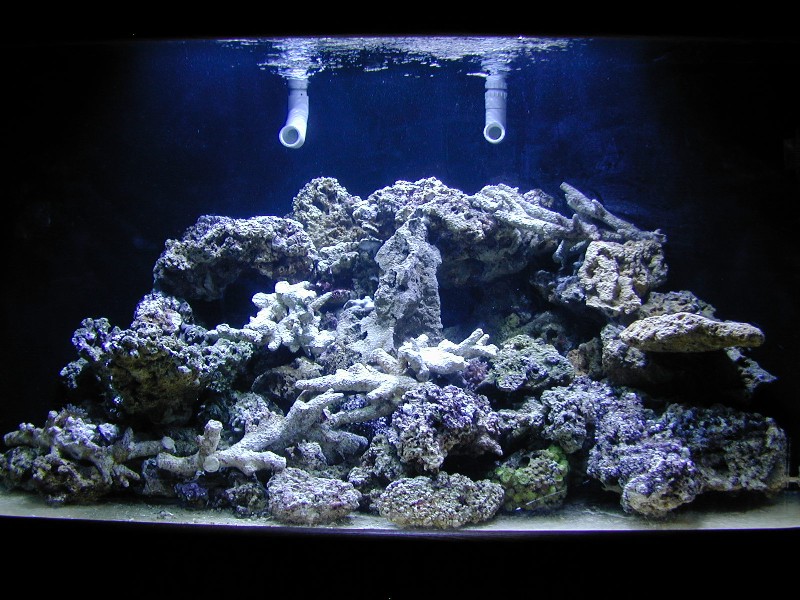I was walking down the aisle of a large discount retailer several years ago, I was in the aquatic section looking at anything they might have relating to my favorite hobby: saltwater. They of course did not, but that is besides the point.
So there I am strolling down the the aisle and I saw all the different attachments and little knick-knacks that you can buy for your freshwater tank. You no doubt have seen them I am sure, they are very hard to miss. Starting with the treasure chest with bubbles, or the pirate skull with bubbles and fake or even dead corals with bubbles. Basically anything with bubbles as an after effect. While these all have their place in a freshwater aquarium, they do not have any place in a reef aquarium.
Have you ever noticed that whenever you see a reef anywhere say like on a postcard or on TV you don’t see those annoying plastic knick-knacks that you see in freshwater aquariums? Reef aquariums are actually quite easy, you never have to spend money on a man-made object for a reef aquarium. They are all alive and growing feeding off the actions that you do to the tank. They reward you for good actions such as regular water changes, constant reef aquarium water parameters and the like. Reefs also reward you with their beauty.

An excellent example of a reef aquascaping design.
Suppose for a minute that all the reefs in the world were flat, all the corals and such were all on the ocean floor with no difference in height or angle. Sounds pretty boring right? Reefs look the most natural by correct aquascaping, which includes placement (height, angle, position to other rocks) of rocks (mainly), corals and return/overflow pipes. Out of all of these however, rock work is the most important.
Upon ordering live rock you most likely did what any reef builder does, put all your new live rock into your aquarium, stacking upon each other and most likely satisfied with the result. What your missing is the art of aquascaping, your reef could look in fact much better in terms of a natural reef and most humans prefer the look of a natural reef, say over a plastic themed one.
When considering aquascaping you should have two things in mind: pleasing to your eyes and comfort to the animals (including corals, fish and inverts). How can this be done? Simple. Think of them as yourself…would you like that rock placed there? Is that coral to close to the intake overflow? Does it look good?
Aquascaping steps and strategies
When you have those two things in mind, its time to move onto the first step. Any good reef has a very good foundation. With a proper foundation you can do advanced rock work with ledges, vallies, and different shelfs. In addition to these new techniques inverts such as the large turbo snail and other marine animals won’t knock your rockwork down, which could very easily injure another animal and create more work for yourself.
How do you create a good foundation? Base rock is the most popular in forming a nice reef foundation. It can easily be bought much less than standard live rock costs and it is very easy to form and break off pieces to form your foundation. You can also use drills and a hammer to get a nice solid foundation.
Arch Design Technique
Most fish actually like to swim under rock arches. These arches are actually very easy to create, by means of either drilling the live rock to allow for zip ties, or using epoxy putty and forging the rocks together to form an arch. Notice the example a simple arch is achieved, however in time corals will grow and the effect will be much more intense and pleasing to the eye.

An example of an arch design technique for rock work.
Color Design Technique
Another area that is often overlooked is placement of color. With this aquscaping technique you have two options, you can either place contrasting colors next to each other, or place corals that look similar in color. In the example photograph the reef builder has used the contrasting color technique to create a very pleasing reef to the eye.

Notice how your eye is focused in on the center coral then widens out.
Dual Masses Design Technique
One technique that is fairly easy to accomplish is the dual masses. Basically it involves two or more stacks of rocks, with a stable foundation. There should be ample space for fish or inverts to swim or flow through the crevice that is created. You can design the masses to be as high as you want, however keep in mind that inverts who climb over the rocks do not get burned by your rock placement.
In recap we have discussed several different techniques of aquascaping which will all make your tank look like a natural reef. Hopefully this guide has given you some insight into aquascaping design and layout.





